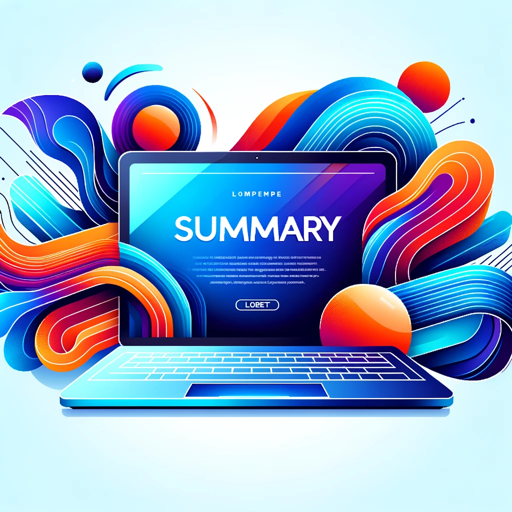Narrative-style research summaries-AI-powered research summaries
AI-driven summaries that narrate your research.
Related Tools
Load More
Paper Digest
Your Academic Assistant: providing assistance in paper reading and writing with insights from 800 million+ academic papers

論文要約くん
落合陽一先生の論文読み方フォーマットで論文を分かりやすく解説してくれます。論文を全文読み、詳細な解説を提供します。プロンプトはいりません、PDFかURLを送るだけです。

Study Summary
Summarizes lecture notes into concise, bullet-point summaries for study.

TLDR Article Summarizer
Summarize articles and web pages: Provides an overview, evaluates pros and cons, poses insightful questions for deeper exploration of the topic, and suggests related articles | #Webpage #Tab #Hoarder #TL;DR #AISalon

Academic paper summary
Expert at processing and summarizing uploaded papers.

Nerdy Novelist's Chapter Summary
This GPT summarizes fiction chapters, preparing them for creating a story bible. Just input the text of your chapter (just one) below.
20.0 / 5 (200 votes)
Introduction to Narrative-Style Research Summaries
Narrative-style research summaries are designed to offer a structured, yet engaging synthesis of complex research findings. These summaries focus on telling a coherent 'story' about the research, weaving together background, methodology, results, and conclusions in a way that is easily understandable. The primary design purpose of narrative summaries is to bridge the gap between technical research papers and broader audiences who may lack domain-specific knowledge. Narrative-style summaries offer more context and connection than traditional abstract or bullet-point summaries, making them valuable for various professional fields and educational settings. For example, a narrative summary of a clinical trial might not only state the results of a drug's efficacy but also describe the historical background of the drug's development and the real-world implications of the findings.

Main Functions of Narrative-Style Research Summaries
Simplifying Complex Information
Example
A narrative summary of a machine learning research paper could explain how a new algorithm improves efficiency by relating it to real-world applications such as autonomous vehicles.
Scenario
In industry settings, stakeholders or decision-makers without deep technical expertise often need to understand the high-level takeaways of advanced research. Narrative summaries make it easier for them to grasp key concepts and assess their relevance to ongoing projects or potential investments.
Contextualizing Research
Example
In a summary of climate change research, the narrative might connect the paper’s findings to ongoing environmental policies, outlining the potential long-term impact on global temperatures.
Scenario
Policymakers and advocacy groups often require context to understand how new research fits into the bigger picture. A narrative-style summary can provide a cohesive story, explaining how the findings contribute to or challenge existing policies or societal trends.
Engaging a Broader Audience
Example
A narrative summary of a biomedical study might highlight a patient's personal story to illustrate how a new treatment protocol could transform individual lives, making the science more relatable.
Scenario
In public health campaigns or educational outreach, communicating science in an engaging manner is crucial. Narrative-style summaries can transform dry, technical information into compelling stories that resonate with the general public, making them more likely to absorb and act on the information.
Ideal Users of Narrative-Style Research Summaries
Professionals in Non-Technical Roles
Executives, project managers, and decision-makers in industries such as healthcare, technology, and environmental services often need to understand research without being bogged down by technical details. Narrative summaries allow them to grasp the implications of research findings quickly, facilitating decision-making in strategic contexts.
Educators and Students
Professors, teachers, and students in undergraduate or graduate programs benefit from narrative summaries because they provide a cohesive understanding of the research, making it easier to teach or learn complex topics. These summaries serve as valuable educational tools, particularly for those new to a subject area.

How to Use Narrative-Style Research Summaries
1. Visit aichatonline.org for a free trial without login.
Start by accessing the platform, which allows users to experience AI-powered narrative-style research summaries without the need for ChatGPT Plus or any initial login.
2. Upload your research paper or choose a relevant document.
Prepare your paper or select a text file related to the research field you want to summarize. Make sure the document is in a supported format, such as PDF or Word.
3. Select the 'Narrative Summary' option.
Once your document is uploaded, navigate to the summary options and choose 'Narrative Summary' to generate an in-depth, flowing account of your research.
4. Customize the output settings.
Adjust the tone, detail level, and length of the summary to suit your needs, whether it's for academic, business, or general informational purposes.
5. Review and refine the generated summary.
After generating the narrative-style summary, carefully review it. You can refine the results using additional feedback mechanisms offered by the platform.
Try other advanced and practical GPTs
Hiring and Recruiting Assistant
Efficient AI-Powered Candidate Search

GPT Creator's Cottage - Creative GPT Place
AI-powered creativity, your ideas, unleashed.

Bea - relationship psychology
AI-powered guidance for deeper relationships.

Unifi Assistant
AI-powered assistant for Unifi networks

3D-Designer
AI-Powered 3D Design Made Easy

AvoidTurnAi
AI-Powered Text Humanizer
Task Slayer
Conquer your to-do list with AI-powered task slaying.

Humanize AI Pro : Undetectable AI
AI-Powered Human-Like Conversations

Nutrition GPT
Optimize your diet with AI insights
Free image, video & audio stock finder
AI-powered free stock media finder

Creator Expert (Seamless Agents)
AI-powered content creation and more.

Strategic Negotiation Pro
AI-powered negotiation excellence

- Academic Writing
- Data Analysis
- Business Reports
- Project Proposals
- Research Reviews
Frequently Asked Questions About Narrative-Style Research Summaries
What is a narrative-style research summary?
A narrative-style research summary provides a flowing, cohesive explanation of research findings, placing them in a clear context and explaining them in an accessible, story-like format.
How are narrative summaries different from traditional summaries?
Traditional summaries often list key points or facts, while narrative summaries are written in a connected, story-like format, making the research easier to follow and more engaging.
Can narrative summaries be used for non-academic purposes?
Yes, narrative summaries are versatile and can be adapted for business, presentations, or general information purposes where a clear, flowing explanation of research is needed.
Do I need to manually edit the generated summaries?
The summaries are typically highly accurate, but reviewing the output is recommended to ensure that it aligns with your specific objectives or style preferences.
Is there a limit on the size or type of research paper that can be summarized?
Most platforms support common research paper formats such as PDFs, but there might be file size limits or restrictions depending on the tool you use.